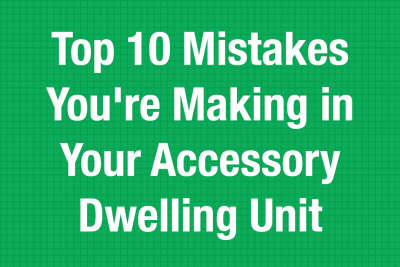
Top 10 Mistakes You’re Making in Your ADU Project
June 30, 2023
Top 10 Mistakes You’re Making in Your Accessory Dwelling Unit (ADU) Project
Are you considering building an Accessory Dwelling Unit (ADU)? These structures can enhance your property’s utility and value. Yet, common mistakes can potentially overshadow the rewards. Let’s unpack these pitfalls.
1. Neglecting to Check Local Building Codes
The first step is to verify local building codes. Each locality has specific rules about ADU projects. These regulations may limit the size, design, or location of your ADU. Without knowing the local codes, you might find yourself redesigning your project or facing penalties.
Remember that codes aren’t just obstacles—they serve a purpose. They ensure that structures are safe and in harmony with the neighborhood. By aligning your project with these codes, you guarantee a smoother building process and better community integration.
Additionally, it’s important to ensure that the builder of your project has previously worked in the city that your construction project is taking place. Each locality has specific codes that may only become evident once you are further along the construction process. This can end up costing you money in the long term to remedy any fixes.
2. Inadequate Budgeting
Project budgeting is an essential second step. Initial costs may include purchasing plans, securing permits, and sourcing construction materials. Moreover, you should expect some costs to exceed your predictions. Therefore, it’s smart to add a contingency to your budget.
A detailed budget also keeps your project grounded in reality. Extravagant plans may need to be scaled down to align with your financial constraints. Remember, an ADU is an investment, and it’s crucial to keep your spending in check.
An additional thing to keep in mind is what kind of materials can be used to keep costs down for your project. You may have a specific idea or aesthetic vision for your ADU, but be open to different ways to achieve the same look.
3. Overlooking Your Property’s Characteristics
Understanding your property is vital. Consider factors like sun exposure, soil type, and landscaping. Such features dictate where and how to build your ADU.
For instance, a south-facing ADU can take advantage of passive solar heating, reducing energy costs. Also, understanding soil type can prevent foundational issues. Customizing your ADU to your property’s specifics ensures a harmonious and sustainable build.
It’s important to design an ADU space that feels coherent with the rest of your property. An ADU should flow with the rest of the property and not stick out like a sore thumb.
4. Ignoring Long-Term Maintenance for your ADU
Maintenance may not be your initial focus, but it’s worth considering. Durable materials may be more costly upfront but can reduce future repair costs. Similarly, the design can affect upkeep—complex designs may require more extensive maintenance.
Your ADU is a long-term investment. Thus, considering maintenance during the planning stage can save time, money, and stress in the future.
5. Skipping Professional Help
The DIY route may seem appealing due to cost savings, but be cautious. Hiring professionals ensures your project meets legal standards and can save you time. Professionals can catch potential issues early, preventing costly mid-project changes.
Professional help doesn’t negate your involvement. You can still make key decisions while relying on experts for implementation. It’s a balanced approach that guarantees quality without sacrificing personal input.
6. Over-designing Your ADU Space
When designing your ADU, remember that less is often more. With limited space, each choice should be thoughtful and functional. Avoid the temptation to fit in every possible feature.
Instead, prioritize essential amenities and focus on creating a comfortable, versatile space. Remember, a well-designed small space can be more satisfying than a cramped, overdesigned one.
7. Forgetting About Privacy
Given the proximity to the main house, privacy can be an issue with ADUs. Implement design choices like strategic window placement or installation of blinds to maintain privacy.
Also, consider sound insulation. Minimizing noise transfer enhances privacy, making both the main house and ADU more enjoyable.
8. Ignoring the Importance of Good Lighting with your ADU
Good lighting is paramount, especially in smaller spaces. It can make your ADU feel larger and more welcoming. Balance natural and artificial light sources for the best effect.
Natural light enhances mood and reduces electricity costs. Incorporate it with large windows or skylights. For artificial light, use layered lighting—combine ambient, task, and accent lights to create a warm, functional space.
9. Overlooking Energy Efficiency
Don’t neglect the importance of energy efficiency. It may seem like an extra expense, but it pays off in the long run. Energy-efficient appliances and insulation can lower utility bills and contribute to a more sustainable future.
Moreover, some local governments offer incentives for energy-efficient homes. So, check your local programs—you might save money while making an environmentally friendly choice.
10. Rushing the ADU Process
Finally, be patient. Building an ADU is a complex process, and rushing can lead to mistakes. Instead, take time to plan thoroughly, make informed decisions, and supervise construction.
This process may seem time-consuming, but it can prevent future problems. A well-planned project minimizes delays, cost overruns, and mistakes. So, slow down and give your ADU the time it deserves.
In conclusion, building an ADU is an exciting journey, filled with opportunities to learn and create. By avoiding these common mistakes, you can ensure a smoother process and a more satisfying result. Take one step at a time, remember the lessons outlined here, and you’ll be well on your way to creating a fantastic ADU. Best of luck in your endeavor!
Further Reading and Resources
To delve deeper into sustainable construction, we recommend these excellent resources from Greenworks Construction. These comprehensive guides provide invaluable insights and expert knowledge on a wide range of topics related to home construction, remodeling, and sustainability.
Accessory Dwelling Unit Design
Want to understand more about designing an accessory dwelling unit? Read this guide.
Home Building Costs in Los Angeles
For insights into the costs associated with home building in Los Angeles, check out this resource.
Kitchen and Bathroom Remodel
Discover the intricacies of kitchen and bathroom remodels with this informative article.
Building Permit Requirements in Los Angeles
Familiarize yourself with Los Angeles building permit requirements with this comprehensive guide.
Earthquake Retrofitting in Los Angeles
Learn about the importance and process of earthquake retrofitting in Los Angeles in this detailed guide.
Accessory Dwelling Unit Permits in Los Angeles
Understand the process for securing an accessory dwelling unit permit in Los Angeles by reading this resource.
Kitchen Remodel Design Choices
Explore the possibilities for your kitchen remodel with this article on design choices.
Backyard Remodel in Los Angeles
Thinking about a backyard remodel in Los Angeles? This guide has all the information you need.
Garage Conversions in Los Angeles
Transform your garage into a functional living space with this guide on garage conversions.


